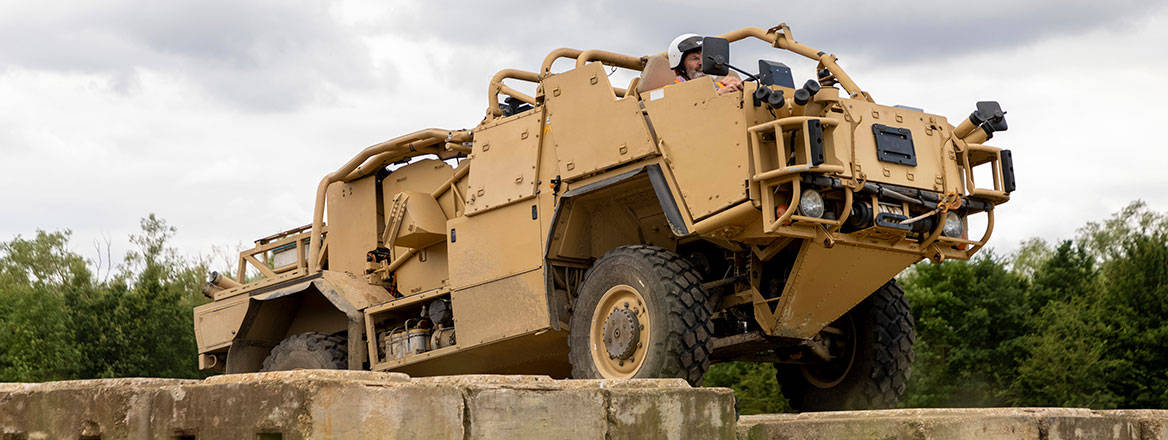Greening Defence: Communicating a Greener Defence
The UK Defence sector is only at the start of its journey towards net zero 2050. The final commentary in this Greening Defence series provides a summary of the progress made so far, and highlights areas for comprehensive communication of current and planned works to deliver success.
The Greening Defence commentaries have examined how the Ministry of Defence (MoD) is developing the Climate Change and Strategic Approach (CC&SSA) into policy, and analysed the different focus areas adopted by the single services. Throughout the study, the response across Defence and its industry partners has been characterised by a high level of innovation and invention, from the grassroots to the upper echelons of command. There are numerous examples of promising pilot schemes with exciting potential if upscaled and rolled out further. However, there has been external criticism: there are many who argue that action has yet to match grandiose, public statements committing Defence to a more sustainable and greener future. Equally, the current pace of activity appears slow and unlikely to meet the requirements for success in Epoch 2 of the CC&SSA, starting from 2025. Despite the success, the importance of an effective communication strategy cannot be underestimated. This will translate Defence’s understanding and requirements to an internal and external audience, in turn facilitating an ability to accelerate and grasp an opportunity to become a genuine world leader in what will increasingly become a priority for Defence, both in the UK and in other states.
How is UK Defence Responding?
Work continues to develop the CC&SSA into policy within the MoD. The Climate Change and Sustainability Directorate, headed by James Clare, is working to ensure clear identification and definition of the problem, and to set the foundations for successful mitigation. This is a monumental, and perhaps unenviable, challenge that needs appropriate resourcing and prioritisation by wider Defence. Clare’s directorate faces an even greater challenge without appropriate resourcing and prioritisation against other Defence departments – it is a case of determining what is important and urgent.
Epoch 1 of the CC&SSA outlines five years to set the conditions for action in future epochs. Defence’s messaging has been very much aligned with a military mindset – one of ‘action now’ in a dramatic attempt to grab the headlines and to resolve the issue immediately. However, Clare’s team is keen to communicate that we are still within the early stages of CC&SSA. Success may not necessarily require dramatic change immediately but the evolution and adaptation of existing processes and practices to mitigate climate change. These changes will ensure that Defence is resilient and prepared to operate in any environment, with a minimised footprint and a limited impact on the environment in keeping with societal and industrial expectations. Technological solutions are likely to follow but betting the budget on experimental ideas now is arguably reckless. Notably, this leaves Defence open to criticism, as much of the work is low-level and may not be apparent from an external perspective. Fundamentally, by focusing initially on business-as-usual practices and inculcating a greener culture across the organisation, Defence buys time for industry to find ground-breaking solutions; every small change contributes towards decarbonisation and the overall target of net zero by 2050.
The policy development during Epoch 1 has allowed the single services the freedom to identify, prioritise and develop relevant responses appropriate to their own bailiwick. Each force has adopted a differing approach whether it is the British Army’s focus on electrification, the RAF’s experimentation with synthetic and sustainable aviation fuels or the Royal Navy’s modular ship designs. All show real potential albeit in their own areas of expertise; it is too early to determine whether these projects will form part of the long-term solution.
The UK armed forces have the potential to become a genuine world leader in climate change and sustainability
The MoD and the single services share the challenge of responding to the estate, and each has begun to experiment with existing civilian technologies to reduce emissions, increase renewable energy production and improve the resilience of the energy supply chain. Here, there have been some missed opportunities to engage with the lessons already learned by the public sector, for example, from civilian engineers of green technologies, local governments and mayoral authorities. However, there have been some amazing examples of incorporating climate solutions into existing funded projects, innovative installation ideas and genuine reciprocal partnerships with industry; of these both RAF Leeming and HMNB Portsmouth are the exemplars in class, and have the potential to inform work across the homebase.
Halfway through Epoch 1 of the CC&SSA, there is still much work to be achieved to ensure that Defence is ready to financially commit to activity and programmes within Epoch 2. With just over two years to go until 2025, now is the time to accelerate, by engaging with existing technologies and lessons learned and to identify the priorities for future development.
Moving Towards Net Zero: Communication is Key
Communicate Externally
Examples of CC&SSA innovation are commonplace across Defence but too often the military has been criticised for not doing more to mitigate climate change. One answer may lie in an appropriate communication strategy. Defence has done a good job of employing environmental buzzwords and to state long-term intentions, but now there is a need to communicate actual progress, to provide the evidence to the outside world. Change takes time; a slow, steady and consistent pace is not a failure but leaves the military open to criticism of inactivity.
Defence Must Communicate Progress, Little and Often. The Environment Requires Its Own Communication Strategy
This will improve both internal and external perceptions and will build greater awareness of the need for climate change mitigation, enhancing a greener culture and encouraging others in the process. Addressing the communications about current and future planned works will help the wider Defence sector to think about how it can respond to the needs of the services, ensuring that all parties are prepared to deliver results.
Communicate Internally
Closely linked to communication is the requirement for greater collaboration. This should be inspired by the wealth of innovation and green projects across Defence to date, with weak or blind spots informed by lessons learned by allied armed forces and/or other public sector organisations, for example, local governments and government departments. Where there is a need for access to education or specialist expertise, think tanks, industry and academia can facilitate or develop access to both one-off and longer-term training opportunities and resources; this is both inexpensive and time-resource effective. With improved education and collaboration comes increased confidence and, ultimately, speed of response.
Communicate with Industry
Defence needs to be realistic about its financial limitations. This means a requirement to work in closer partnership with industry on environmental issues and requires a greater communication of priority areas, available budgets and likely timescales. The commercial sector has a wealth of resources, knowledge and expertise to develop future solutions but is often unable to access Defence. New strategies, such as the Land-Industrial strategy, may provide the processes for greater partnerships but remain unproven at present. This partnership will become even more important with the move to Epoch 2, where Defence will place a greater focus on operational capabilities rather than the estate, and industry is likely to play a pivotal role in the development of greener platforms. Additionally, greater collaboration will help to identify the grassroots projects to be taken forward and provide a route to market for upscaling (subsequently communicating success internally and externally!).
A World-Leading Opportunity
Communicate Globally with Other Militaries
The UK armed forces have the potential to become a genuine world leader in climate change and sustainability. On an international stage, the UK’s partners and allies are also working to confront the same challenges and it is becoming increasingly clear that there remains a vacuum for a national armed force to step into the position of global leader. The UK is well placed to respond to this gap in the market, to become a leader in environmental education. The importance of climate change has also been recognised by NATO in its Climate Change and Security Impact Assessment, which acknowledges climate change as an ‘overarching challenge of our time’. Equally, NATO’s new Strategic Concept features climate change as an explicit global threat for the first time. The likely increase in climate-related operations (whether humanitarian relief or increased conflict over resource scarcity) will also require specialist environmental expertise and a lead state for coordinated responses. The opportunity exists if the UK wants the position and takes active measures now.
Building Momentum from the Strategic Approach
Since the launch of the CC&SSA, Defence has reached a pivotal point where it needs to take decisive action to commit fully to its grandiose, public statements; now Defence requires a collaborative and aligned strategy to respond to climate change. To date, the pace of change has been steady if not fast; this is adequate for now but is likely to require acceleration. Whether Defence is prepared, or even able, to speed up remains to be seen. In the meantime, communication must be improved internally to Defence, and externally, with other government departments, industry and international partners. This will alleviate concerns, improve understanding and awareness, and facilitate greater innovation and invention. Defence has a rare opportunity to achieve the rhetoric and to become a global lead supported by industry – this will not only prove politically appealing but will achieve financial benefits.
If you have enjoyed the Greening Defence commentary series so far, please check out the Greening Defence podcast, created in partnership with the Conflict and Environment Observatory. The podcast brings together experts from defence, industry and academia to discuss key themes such as culture, technology and sustainability across the Ministry of Defence and the single services. The Greening Defence podcast launched on Thursday 11 August, with episodes released fortnightly via all the usual podcast channels, such as Spotify, Amazon Prime and Apple Music.
The views expressed in this Commentary are the authors’, and do not represent those of RUSI or any other institution.
Have an idea for a Commentary you’d like to write for us? Send a short pitch to commentaries@rusi.org and we’ll get back to you if it fits into our research interests. Full guidelines for contributors can be found here.
Dr Sarah Ashbridge
Affiliate Expert, Military Sciences
Lieutenant Colonel Alistair Beard
Former Army Visiting Fellow
- Jim McLeanMedia Relations Manager+44 (0)7917 373 069JimMc@rusi.org



